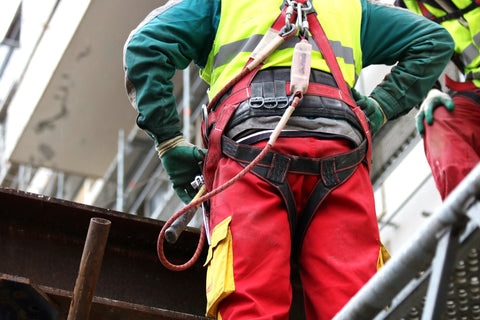When it comes to fall protection, it's often the small details that make the difference between life and death. Unfortunately, as fall protection trainers, we see the same mistakes repeated time and time again in workplaces around the country.
1. incorrect control of the anchorage point
The problem: Many users assume an anchorage point is secure without checking it properly.
What can happen: A weak anchorage point can give way in a fall, rendering all other safety equipment useless.
How to do it right:
● Always check that the anchorage point can withstand at least 10 kN (about 1000 kg)
● Visually inspect for cracks, corrosion or other damage
● Only use certified anchorage points
● Document your check
2. Forgot to check the drop height
The problem: The user does not think about how far they can fall before the safety system stops them.
Example calculations:
● Working height: 4 meters
● Rope length: 2 meters
● Reach + body length: 2 meters
● Total fall height: 4 meters ⚠️
How to avoid the problem:
● Always calculate the total fall height before working
● Use shorter ropes or fall stops when necessary
● Create a safety zone below the work area
● Plan the work to minimize the risk of falling
3. improper use of seat belts
One of the most shocking misunderstandings we come across is how to wear a seat belt.
Common mistakes:
❌ Loose straps
❌ Misplaced belts
❌ Connecting at the wrong point on the harness
❌ Using a damaged harness
Correct use:
✅ All straps should be tightened to fit a maximum of 2 fingers
✅ Always connect at the back point for optimal body support
✅ Check the harness before each use
✅ Follow the manufacturer's instructions carefully
4. Lack of communication in the team
The scenario: An electrician is working at a height of 8 meters.
His colleague on the ground moves the ladder without telling him. The electrician tries to climb down and...Communication saves lives. Period.
How to communicate safely:
● Establish clear signals before work starts
● Use radios or headsets if necessary
● Appoint a safety officer to supervise work
● Have regular safety reminders
How to avoid the problem:
● Always calculate the total fall height before work
● Use shorter ropes or fall arrest when necessary
● Create a safety zone below the work area
● Plan work to minimize the risk of falling
5. lack of training and repetition
Frightening statistics:
67% of fall accidents occur among people with less than 2 years of experience
23% of accidents are due to lack of knowledge of the equipment
The solution:
● Basic training for all new employees
● Refresher training at least every two years
● Practical training with real equipment
● Mentoring where experienced workers guide new ones
How to avoid the problem:
● Always calculate total fall height before work
● Use shorter ropes or fall stops when necessary
● Create a safety zone below the work area
● Plan work to minimize fall risk
What are you doing now?
After reading this post, take 5 minutes to think:
Have I made any of these mistakes?
What are the security practices in my workplace?
When was the last time I took a refresher course?



